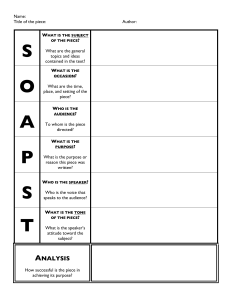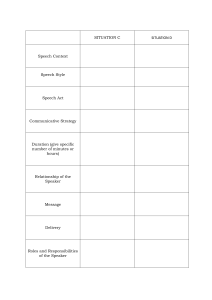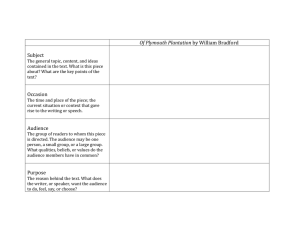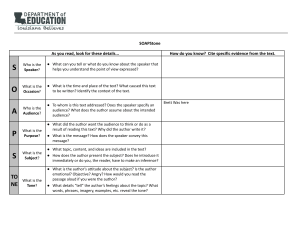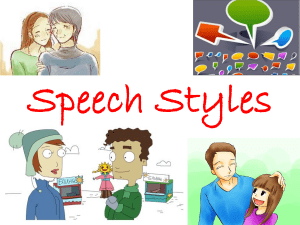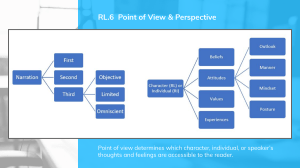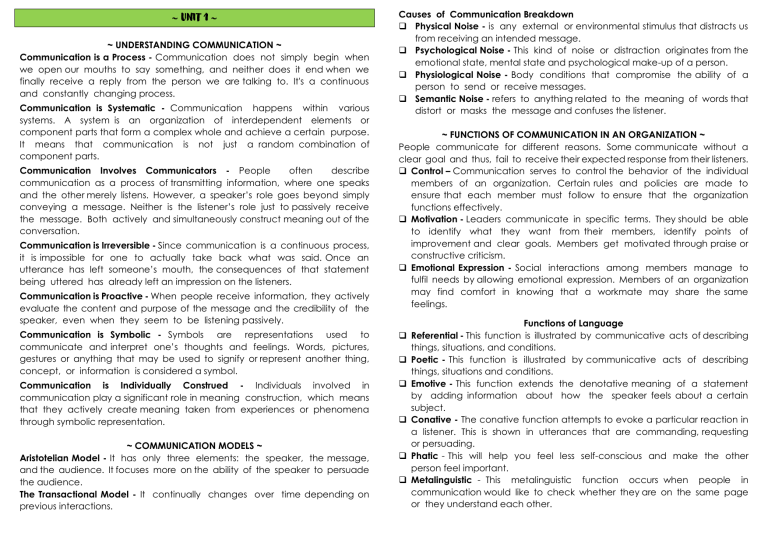
~ UNIT 1 ~ ~ UNDERSTANDING COMMUNICATION ~ Communication is a Process - Communication does not simply begin when we open our mouths to say something, and neither does it end when we finally receive a reply from the person we are talking to. It's a continuous and constantly changing process. Communication is Systematic - Communication happens within various systems. A system is an organization of interdependent elements or component parts that form a complex whole and achieve a certain purpose. It means that communication is not just a random combination of component parts. Communication Involves Communicators - People often describe communication as a process of transmitting information, where one speaks and the other merely listens. However, a speaker’s role goes beyond simply conveying a message. Neither is the listener’s role just to passively receive the message. Both actively and simultaneously construct meaning out of the conversation. Communication is Irreversible - Since communication is a continuous process, it is impossible for one to actually take back what was said. Once an utterance has left someone’s mouth, the consequences of that statement being uttered has already left an impression on the listeners. Communication is Proactive - When people receive information, they actively evaluate the content and purpose of the message and the credibility of the speaker, even when they seem to be listening passively. Communication is Symbolic - Symbols are representations used to communicate and interpret one’s thoughts and feelings. Words, pictures, gestures or anything that may be used to signify or represent another thing, concept, or information is considered a symbol. Communication is Individually Construed - Individuals involved in communication play a significant role in meaning construction, which means that they actively create meaning taken from experiences or phenomena through symbolic representation. ~ COMMUNICATION MODELS ~ Aristotelian Model - It has only three elements: the speaker, the message, and the audience. It focuses more on the ability of the speaker to persuade the audience. The Transactional Model - It continually changes over time depending on previous interactions. Causes of Communication Breakdown ❑ Physical Noise - is any external or environmental stimulus that distracts us from receiving an intended message. ❑ Psychological Noise - This kind of noise or distraction originates from the emotional state, mental state and psychological make-up of a person. ❑ Physiological Noise - Body conditions that compromise the ability of a person to send or receive messages. ❑ Semantic Noise - refers to anything related to the meaning of words that distort or masks the message and confuses the listener. ~ FUNCTIONS OF COMMUNICATION IN AN ORGANIZATION ~ People communicate for different reasons. Some communicate without a clear goal and thus, fail to receive their expected response from their listeners. ❑ Control – Communication serves to control the behavior of the individual members of an organization. Certain rules and policies are made to ensure that each member must follow to ensure that the organization functions effectively. ❑ Motivation - Leaders communicate in specific terms. They should be able to identify what they want from their members, identify points of improvement and clear goals. Members get motivated through praise or constructive criticism. ❑ Emotional Expression - Social interactions among members manage to fulfil needs by allowing emotional expression. Members of an organization may find comfort in knowing that a workmate may share the same feelings. Functions of Language ❑ Referential - This function is illustrated by communicative acts of describing things, situations, and conditions. ❑ Poetic - This function is illustrated by communicative acts of describing things, situations and conditions. ❑ Emotive - This function extends the denotative meaning of a statement by adding information about how the speaker feels about a certain subject. ❑ Conative - The conative function attempts to evoke a particular reaction in a listener. This is shown in utterances that are commanding, requesting or persuading. ❑ Phatic - This will help you feel less self-conscious and make the other person feel important. ❑ Metalinguistic - This metalinguistic function occurs when people in communication would like to check whether they are on the same page or they understand each other. ~ UNIT 2: COMMUNICATING ACROSS CULTURES ~ A Marriage made in Hell The Partnership Between CORNING and VITRO Corning - A US global glassmaker and fiber optics manufacturer. Vitro - Mexico’s largest industrial group. Both companies: 1. Were customer oriented 3. Still had founding families in control 2. Were aggressive global marketers They differ in: ❑ OFFICE Corning - Modern offices in upstate New York feature streamlined glass structure. Vitro - Headquarters in historic Monterrey are a replica of a 16th-Century Convent, with artwork, arched ceilings, gardens and fountains. ❑ MANAGEMENT STYLE Corning managers complained that important deadlines were often missed because only top managers could make decisions in Vitro. Mexicans faulted the Americans for being too direct and pushy. Vitro managers, practicing politeness, appeared to the Americans to be unwilling to recognize problems and weaknesses. The Mexicans generally thought that Corning moved too fast; the Americans grumbled that Vitro was too slow. Understanding Culture Culture is a complex system of values, traits, morals, and customs shared by a society. Characteristics of Culture: 1. Culture is learned. 2. Cultures are inherently logical. 3. Culture is the basis of Self-Identity and Community. 4. Culture combines the visible and invisible. 5. Culture is dynamic. Five Key Dimensions of Culture 1. CONTEXT: ❑ Low-Context (Germany, North-America, Scandinavia, Philippines) ❑ High-Context (Japan, China, Latin America, Arab Countries) Local Context Culture simply means that information must be explicit and detailed for the message to be conveyed without distortion. That is why mostly communicators in this context assures that conclusions are explicitly stated. While High Context Culture means that information are not transmitted alone but also through non-verbal cues such as gestures, tone of the voice, and facial expression, which can have different meanings in different cultures. Contrasts between Low-Context and High-Context Cultures: ❑ LCC tends to prefer verbal interaction, while HCC tends to prefer indirect verbal interaction. ❑ LCC tends to understand meaning at one level only, while HCC tends to understand meanings embedded at many sociocultural levels. ❑ LCC is generally less proficient in reading non-verbal cues, while HCC is generally more proficient in reading non-verbal cues. ❑ LCC values individualism, while HCC values group membership. ❑ LCC relies more on logic, while HCC relies more on context and feeling. ❑ LCC says “no” directly, while HCC talks around point; avoids saying no. ❑ LCC communicates in highly structured messages, provides details, stresses literal meanings, gives authority to written information. While HCC communicates in simple, ambiguous messages; understands visual messages readily. 2. INDIVIDUALISM - an attitude of independence and freedom from control. LCCs believe in individual action and personal responsibility, and they desire a large degree of freedom in their personal lives. HCCs are more collectivists. They emphasize membership in organizations, groups, and teams; they encourage acceptance of group values, duties, and decisions. They resist independence because it fosters competition and confrontation instead of consensus. 3. FORMALITY In business dealings, LCCs come to the point immediately; indirectness, they feel, wastes time, a valuable commodity particularly in American Culture. In HCCs a typical business meeting begins with handshakes, coffee, and an expansive conversation about the weather, sports, and other light topics. An invitation to get down into business might offend a Mexican Executive. In Japan, signing documents and exchanging business cards are important rituals. 4. COMMUNICATION STYLE In LCCs, words are very important, especially in contracts and negotiations. HCCs place more emphasis on the surrounding context than on the words describing a negotiation. 5. Time Orientation LCCs tend to correlate time with productivity, efficiency, and money. HCCs tend to need time for deliberation and contemplation. ~ UNIT 2: BUSINESS COMMUNICATION AND CULTURES ~ Culture is a system of shared values, beliefs, and behaviors that influence and are influenced by communication. Metacommunication - To exchange evidence of ideas and feelings, using more than words. It reflects cultural values, particularly with respect to use of space, use of time, and use of gestures and facial expressions. 1. Space ➢ The space we maintain with our bodies suggests a desire to control closeness. ➢ On space: ✓ The US is a noncontact society ✓ Middle Eastern Culture & the Latin American - require close proximity during a conversation ✓ North American - consider such closeness an invasion of personal space ➢ On office space: ✓ US - space and location connote status ✓ Middle East - it seems to convey little significance ✓ France - the manager is located amid subordinates so that he can exercise control conveniently 2. Use of Time ➢ US - 5 minutes is a significant unit of time ➢ France - 15 minutes is perceived as a significant delay ➢ Latin America & Middle East - long waiting periods are customary in business ➢ Japan - delays of months or even years does not signify loss of interest in negotiating an important business contract. ➢ North America - view such delay as serious hindrances ➢ Middles East - the imposition of due dates and deadlines suggests inconsideration, even rudeness and justify ignoring such schedules. 3. Gestures and Facial Expressions Cultures vary widely in how they use the hands and the face in communication. Although the handshake is an almost universal business greeting, its strength and form differ across cultures. ➢ Handshakes: Cultural Differences ✓ US: firm ✓ British: Soft ✓ Hispanics: Moderate grasp, repeated frequently ✓ Germans: Firm repeated upon arrival and departure ✓ French: Light, quick, not offer to superiors, repeated upon arrival and departure ✓ Middle Easterners: Gentle, repeated frequently ✓ Asians: Gentle, for some, shaking hands is unfamiliar and uncomfortable (an exception is the Korean who generally has a firm handshake) ➢ Variations in eye contact ✓ Middle Easterners, some Hispanic groups, the French = Very direct eye contact - a desire to express an interest, a desire to communicate effectively ✓ Americans, Northern Europeans, the British = Moderate eye contact - a desire not to appear aggressive or intrusive ✓ East Asians, Southeast Asians, East Indians, Native Americans = Minimal eye contact - a desire to show respect. Dimensions of Culture The more you know about culture in general and your own culture in particular, the better able you will be to adapt to a multicultural perspective. Context A concept developed by cultural anthropologist Edward T. Hall. According to him, context refers to the stimuli, environment, or ambience surrounding an event. Contrasts between Low-Context and High-Context Cultures: In the 2nd page. What are the low context cultures? German America North American Western Europe Philippines Chinese What are the high context culture? German-Swiss Mexican Japanese Scandinavian English Greek Spanish French Italian Arab How to achieve Multicultural Sensitivity Avoid Ethnocentrism: - “The belief in the superiority of one’s own race.” Bridge the Gap - Tolerance - Patience - Respect - Knowledge Move beyond Stereotypes - A stereotype is an oversimplified behavioral pattern applied uncritically to groups. ~ UNIT 2: ETHICS IN BUSINESS COMMUNICATION ~ Business Ethics is considered as an “oxymoron”, a combination of contradictory words. Before there was “ Greed is good” era of the 1980s. Now, there is CSR or Corporate Social Responsibility. Ethical awareness grows as companies recognize that ethical practices make good business sense. There is now an explosion of ethical awareness because ethical companies endure less litigation, less resentment, and less government regulation. Employees common ethical violations: ❑ Cutting corners on quality ❑ Covering up incidents ❑ Abusing or lying about sick days ❑ Deceiving customers ❑ Lying to a supervisor or underling ❑ Taking credit for a colleague’s ideas Ethical behavior means doing the right thing given the circumstances. Five Common Ethical Traps: 1. The False Necessity Trap - People act from the belief that they’re doing what they must do. They convince themselves that they have no other choice, when in fact it’s generally a matter of convenience or comfort. 2. The Doctrine-of-Relative-Filth Trap - Unethical actions sometimes look good when compared with the worse behavior of others. 3. The Rationalization Trap - In falling into the rationalization trap, people try to explain away unethical actions by justifying them with excuses. 4. The Self-Deception Trap - Applicants for jobs most commonly fall into this trap. They are willing to inflate grade-point averages or exaggerate past accomplishments to impress prospective employers. 5. The Ends-Justify-The-Means-Trap - This trap requires taking unethical actions to accomplish a desirable goal. Business communicators can minimize the danger of falling into ethical traps by setting specific ethical goals. Goals of Ethical Business Communicators: ❑ Telling the truth - ethical business communicators do not intentionally make statements that are untrue or deceptive. ❑ Labeling Opinions - Sensitive communicators know the difference between facts and opinions. Facts are verifiable and often are quantifiable; opinions are belief held with confidence but without substantiation. ❑ Being objective - Ethical business communicators recognize their own biases and strive to keep them from distorting a message ❑ Communicating clearly - Ethical business communicators feel an obligation to write clearly so that the receiver will understand easily and quickly. ❑ “Plain English Laws” - require businesses to write policies, warranties and contracts in language comprehensible to average readers. Plain English - means short sentences, simple words and clear organization. ❑ Giving credit - Ethical communicators give credit for ideas by: 1. Referring to originator’s names within the text. 2. Using quotation marks 3. Documenting sources with endnotes, footnotes, or internal references. Resolving ethical issues is never easy. To make it less difficult, identify key issues: 1. Is the action you are considering legal? 2. How would you see the problem if you were on the opposite side? 3. What are alternative solutions? 4. Can you discuss the problem with someone whose advice you trust? 5. How would you feel if your family, friends, employer, or coworkers learned of your action? The best advice in ethical matters is contained in the Golden Rule in the Bible: “Do unto others as you would have others do unto you.” The ultimate solution to all ethics problems is treating others fairly and doing what is right to achieve what is good. ~ UNIT 2: ETHICAL CONSIDERATION IN GLOBAL COMMUNICATION~ “New Normal” is the buzz these days. We call the advent of using online learning as the new normal in education. Our lives have clearly been reshaped by the coming of Corona and along with using face masks and other PPEs as part of the normal activities we do every day, as well as education. Technology, internet, social media, Netflix have already invaded the conservative world of the academe. We can’t deny the usability of social media to education. Being digital natives give you the upper hand in these day’s educational system. Before we discover how we can stay ethical using the not-so-new platforms in learning. Let us yet explore on the different uses of our favorite, Social Media. Social Media Social Media refers to the web-based and mobile communication applications that lets people interact with each other and build networks. It is a group of internet-based applications that build on the ideological and technological foundations allowing the creation and exchange of user generated content. Online magazines, internet forums, weblogs, social blogs, podcasts, photographs, videos, ratings and social book marking are considered part of social media. Social media is classified into collaborative projects such as Wikipedia, blogs, microblogs like Twitter and content communities like YouTube. USES OF SOCIAL MEDIA ❑ COMMUNICATION - Social Media functions as a communication tool to the generation of today. Exchange of messages, video calls, emails and chats are the usual. ❑ CONNECTION - Social Media has made it possible for people to stay connected wherever they are in the world. In the same way, people also resort to social media for news instead of reading them on the papers. ❑ CAUSE SUPPORT - Most mobile applications have been used by influential people like celebrities and bloggers to show their support for a cause. ❑ CLIENT SERVICE - Big online shopping businesses such as Amazon, Lazada and other small time online shopping businesses use social media to connect with their customers. ❑ COMPETITION - Part of the marketing strategies of businesses these days is to give out a sort of competition or giveaways through the use of social media. ❑ COMMUNITY SERVICE - Some accounts in social media have been designed solely for the purpose of serving the community. ❑ COMMUNICATION RESEARCH - The utilization of these apps have been used for communication research and to further developments in communication. THE VITAL CHARACTERISTICS OF ETHICAL COMMUNICATION 1.) Conveying the point without offending the audience. 2.) Maintain a relationship with the audience. 3.) Avoid withholding crucial information. 4.) Well-organized value system. 5.) Accuracy of information is necessary. LEGAL ASPECTS OF COMMUNICATION Some Legal Violations that You Should Avoid ❑ DEFAMATION - Any false communication, either written or spoken, that harms a person’s reputation; decreases the respect, regard or confidence in which a person is held; or induces disparaging, hostile or disagreeable opinions or feeling against a person. ❑ LIBEL - If the defamatory statement is printed or broadcasted over the media. ❑ SLANDER - Defamatory statement is oral. Public figures, including officeholders (politicians) and candidates have to show that the defamation was made with malicious intent and was not just fair comment. ❑ FRAUD - A false representation of a matter of fact, whether by words or by conduct, by false or misleading allegations, or by concealment of what should have been disclosed-that deceives and is intended to deceive another so that the individual will act upon it to her or his legal injury. ❑ PLAGIARISM - Is the act of taking another person’s writing, conversation, song or even idea and passing it off as your own. This includes information from web pages, books, songs, television shows, email messages, interviews, articles, artworks or any other medium. ~ UNIT 3: VARIETIES AND REGISTERS OF SPOKEN AND WRITTEN LANGUAGE ~ CHARACTERISTICS OF WRITTEN AND SPOKEN LANGUAGE Written Language ❑ Permanence - Once something is written down and delivered in its final form to its intended audience, the writer abdicates certain power, the power to amend, to clarify and to withdraw. ❑ Formality - Writers must be able to identify whether a write up has to be written with a friendly tone (casual) or a more professional tone (formal) ❑ Production Time - Given appropriate stretches of time, a writer can become indeed a good writer by developing efficient processes for achieving the final product. However, in most educational contexts require students writing within time limitations or writing for compliance and display. ❑ Complexity - Good writers must be good at activities like: removing redundancy, combining sentences, making references of other elements in a text, creating syntactical and lexical variety. The distance factor has to have cognitive empathy. This means that good writers can read their own writing from their perspective of the mind of the targeted audience. It is essential for the writer to predict the general knowledge of the audience. ❑ Vocabulary - All write-ups, from simple debut messages to full blown researches, are written by mastering dozens and dozens of letters, symbols and words. Writers must take advantage of the richness of the English vocabulary. Spoken Language Characteristics of Spoken Language 1. Variation in speed 5. Stress 2. Loudness & quietness 6. Rhythm 3. Gestures 7. Pitch range 4. Intonation 8. Pausing and Phrasing LANGUAGE REGISTERS ❑ Register - is defined as the way a speaker uses language differently in different circumstances. Think about the words you choose, your tone of voice, even your body language. You probably behave very differently chatting with a friend than you would at a formal dinner party or during a job interview. FROZEN REGISTER - is sometimes called the static register. Language that rarely or never changes. A good example would be a historic language that is intended to remain unchanged. Examples: The Bible, Pledge of Allegiance, “Romeo and Juliet” FORMAL REGISTER - This register is used in professional, academic, or legal settings where communication is expected to be respectful, uninterrupted, and restrained. Less rigid but still constrained. Slangs are never used, and contractions are rare. Examples: TED talk, Interviews, a business presentation, Encyclopedia Britannica CONSULTATIVE REGISTER - People often use this register when they are speaking with someone who has a specialized knowledge or who is offering advice. Tone is often respectful (use of courtesy titles) but may be more casual if the relationship is long standing or friendly. (family doctor) Slang is often used and may interrupt each other. Examples: A check up, student and teacher consultation, service provider plumber. CASUAL REGISTER - This is the kind of register we use when we are with friends, close acquaintances, co-workers and family. Use of slang, contractions and vernacular is all common. Examples: A birthday party, a backyard barbecue INTIMATE REGISTER - This register is reserved for special occasions, usually between two people and often in private. Intimate language may be something as simple as an inside joke between two college friends or a word whispered in a lover’s ear. TONE OF VOICE “Tone of Voice” is actually “the way a person is speaking to someone. ” In essence, it's how you sound when you say words out loud. Why Should You Get Tone Right? Tone of voice gives you the opportunity to advertise your best self. If the kinds of customers you want to attract are businessmen and women, your tone might be authoritative and professional, but if you’re targeting teenagers, then it should be more light-hearted and quirky. Communicating passionately, quietly or angrily can completely impact how people interpret you. Tone of voice can demonstrate your warmth, expertise, sense of humor, or any other attribute that you want to display to consumers, and sets you apart from your competition. When customers identify a tone of voice, they’re also identifying a personality. They start to form an image of a person or company based on the tone of voice you present. By doing this, customers feel like they’re getting to know the brand or company, bringing with it a sense of trust and familiarity. That familiarity is comforting, as they then know what to expect from you. Once you have gained the trust of your potential customers, you can use this to influence their decisions and persuade them into doing business with you. After all, they are more likely to do business with a company they like and trust. ~ UNIT 3: UNDERSTANDING & EVALUATING MULTIMODAL TEXTS ~ The advent of technology has brought about more complex and diverse ways of communicating and influencing others. Multimodal texts are characterized by the combination of the five different modes of communication: 1. Linguistic Mode 2. Visual Mode 3. Gestural Mode 4. Audio Mode 5. Spatial Mode Elements or features of Linguistic: ❑ Word Choice ❑ Delivery of spoken or written text (tone) ❑ Organization of sentences, phrases, paragraphs ❑ Accent ❑ Coherence Elements or features of Visual: ❑ Color ❑ Arrangement ❑ Layout and style ❑ Size Elements or features of Gestural: ❑ Body language ❑ Facial expressions ❑ Hand gestures Elements or features of Audio: ❑ Ambient noise/sounds ❑ Silence ❑ Sound effects ❑ Volume of sound ❑ Music ❑ Tone of the voice Elements or features of Spatial: ❑ Proximity between people and objects ❑ Perspective ❑ Organization of things What Is Language Register? What is language register? The language register (also called linguistic register and speech register) definition describes the way a person speaks in relation to their audience. A speaker modifies their language register to signal levels of formality according to their relationship to their audience and intended purpose of speech. In English, for example, a speaker might modify their speech to fit a formal language register by using more complex vocabulary and clear articulation, and by omitting any slang or informal speech. Any type of spoken or written communication uses a language register because register is a type of linguistic variation. Linguistic variation describes the complex ways speakers modify their language use according to social cues, communication context, and personal expression. Language register, therefore, can be defined as the type of linguistic variation that indicates level of formality and speaker-audience relationship. Conveyance of language register involves complex, nuanced linguistic variation that differs from language to language and within dialects of the same language. A higher register sounds more official, formal, and standard; a lower register sounds informal, casual, and often uses regional or dialectal phrasing that is not standard. Language register can be gauged on a scale from the most formal (or highest register) to the least formal (or lowest register). Language register is a sociolinguistic construct. Sociolinguistics is the branch of linguistics that examines language as a social tool. Because language register is deeply enmeshed in social norms, it is a component of sociolinguistic communication. This lesson only discusses English (primarily Standard American English), so the examples used here do not necessarily apply to other languages. Types of Register There are many types of language registers in linguistics, and linguists employ the term (and their own definitions) differently depending on their research context. Generally, language register can be divided into several types that describe a range of speech register from extremely formal to extremely casual. Formal register, for example, describes language that carries an objective, professional tone. Martin Joos American linguist Martin Joos (1907–1978) defined five main language register types. These five types are not exhaustive, but rather aim to describe the most typical types of language registers used by English speakers. Joos also defined four differentiating factors that influence the use of language register. These factors are: 1. 2. 3. 4. audience topic purpose location They relate to the modification of language register because they each indicate to speakers and listeners what is appropriate and influence acceptable uses of speech. For example, most people speak differently to their grandparents than to their friends because they are very different audiences. Audience describes the group listening to the speaker (in many conversations the speaker is also a member of the audience because of conversational turntaking); topic describes what is being discussed; purpose describes the intentions of each speaker (both what they intend to communicate and how they intend to communicate it); location describes where an exchange is taking place. 2. Formal Register Formal register describes speech that is elevated, precise, and often professional, official, or impersonal in nature. In English, many components of the formal register involve the use of standard grammar. A speaker using formal register might, for example, ensure that they use complete sentences, standard vocabulary, and exact pronunciation of words. Often, the audience listening to a speaker using formal register does not participate in the conversation, and rather is expected to listen without interrupting. The topics discussed using this register vary but are usually official matters, such as a professional meeting, a graduation ceremony, or an academic lecture. The professional nature of formal register means that it is not suitable for discussing personal topics. The purpose for a speaker employing formal register is often to inform an audience about a topic, but it can also indicate a lack of personal speaker-listener relationship. Formal register is often used in public locations, especially in situations where new people are meeting for the first time or where people are expected to follow official protocols. Formal register is often used by professors during academic lectures, whereas consultative register is used to engage students in discussion. language register formal consultative academic registers 1. Frozen Register Frozen register describes speech that is so formalized that it is often produced via recitation rather than spontaneous speech production. This can also be described as ritualistic speech and is sometimes called static register because the utterances are spoken exactly the same each time. Some examples of a frozen register include reciting a pledge, a prayer, or wedding vows. The intended audience for this register varies, and its use is common in many public situations. Usually, the audience knows what the speaker will say because utterances that use frozen register are learned verbatim and do not change over time. The topic for these utterances can be both formal and informal because these utterances are often verbal recitations of collectively held beliefs. For example, reciting wedding vows is both formal as a legally binding ceremony, but informal due to the intimate nature of a wedding. The purpose of this register is usually to convey a clear legal or spiritual idea. These utterances are often used in a public location, though this is certainly not always the case. 3. Consultative Register Consultative register describes speech that involves the participation of all parties. A speaker employs consultative register to discuss a topic, and the listener(s) must contribute feedback to the speaker. The speaker and listener(s), when using consultative register, are both members of the audience. In English, this register can use both standard and nonstandard grammatical forms, the use of which is heavily reliant on social context. For example, it is more appropriate to use nonstandard speech when addressing a cashier using consultative register than with a professor. This type of discourse is usually used between a doctor and patient, student and teacher, or boss and employee, though it can be used between peers. The nature of consultative register renders it useful for both formal and informal topics of discussion. The purpose of this register is to establish a conversational style that engages both parties, often to inform the listener about a specific topic. Consultative register is appropriate for many locations, but the location must be able to accommodate the listener to provide feedback to the speaker. 4. Casual Register Casual register (sometimes also called informal register) describes speech that is informal or imprecise. This type of speech uses many nonstandard grammatical forms, such as slang, incomplete sentences, or regional phrasing. This register is often used between people who are already acquainted with one another and relies on a relaxed social context. The audience of a speaker using casual register is most likely to be an acquaintance, friend, or peer. These audience members are likely to contribute to the conversation using casual register as well. The topics of discussion for casual register are those that are informal but not too personal. This register primarily serves to accommodate normal conversations that do not require complex explanations, are imbalanced in terms of speaker-listener participation, and move from topic to topic naturally. Casual register is often used in public or semi-public locations when formal or consultative registers are inappropriate, or in a private environment when the topic of conversation does not require the use of intimate register. 5. Intimate Register Intimate register describes speech that is about personal topics used between close acquaintances, such as family members, close friends, or romantic partners, and can employ standard or nonstandard grammatical forms. A listener will usually also use intimate register to reply to someone also using this register. Intimate register is used to discuss topics that the speaker does not wish to be public knowledge, such as personal stories, problems at work or school, or secrets. The appropriate locations to use intimate register are those that are private or can feel private to the participants. The purpose of intimate register is not just to convey matters that are personal; it is also important in strengthening emotional connections between individuals, as its mutual use between participants indicates an empathetic conversation. Kaswirti, kompleto nat notes. Upaya nga mag basa HAHAHA.
